Intro to Psychology | Unit 1
1/109
Earn XP
Description and Tags
Based on NOBA's "Discover Psychology 2.0 - A Brief Introductory Text." For PSYCH 110, chapters 1 - 4.
Name | Mastery | Learn | Test | Matching | Spaced |
|---|
No study sessions yet.
110 Terms
Action Potential
A transient all-or-nothing electrical current that is conducted down the axon when the membrane potential reaches the threshold of excitation.

Axon
Part of the neuron that extends off the soma, splitting several times to connect with other neurons; main OUTPUT of the neuron.
Brain Stem
The “trunk” of the brain comprised of the medulla, pons, midbrain, and diencephalon.
Broca’s Area
An area in the frontal lobe of the left hemisphere. Implicated in language production.

Central Nervous System
The portion of the nervous system that includes the brain and spinal cord.
Cerebellum
The distinctive structure at the back of the brain, Latin for “small brain.”
Cerebrum
Usually refers to the cerebral cortex and associated white matter, but in some texts includes the subcortical structures.
Contralateral
Literally “opposite side”; used to refer to the fact that the two hemispheres of the brain process sensory information and motor commands for the opposite side of the body (e.g., the left hemisphere controls the right side of the body).
Corpus Callosum
The thick bundle of nerve cells that connect the two hemispheres of the brain and allow them to communicate.

Dendrites
Parts of a neuron that extend away from the cell body and are the main INPUT to the neuron.
Diffuse Optical Imaging (DOI)
A neuroimaging technique that infers brain activity by measuring changes in light as it is passed through the skull and surface of the brain.
Electroencephalography (EEG)
A neuroimaging technique that measures electrical brain activity via multiple electrodes on the scalp.
Functional Magnetic Resonance Imaging (fMRI)
A neuroimaging technique that infers brain activity by measuring changes in oxygen levels in the blood.
Limbic System
Includes the subcortical structures of the amygdala and hippocampal formation as well as some cortical structures; responsible for aversion and gratification.
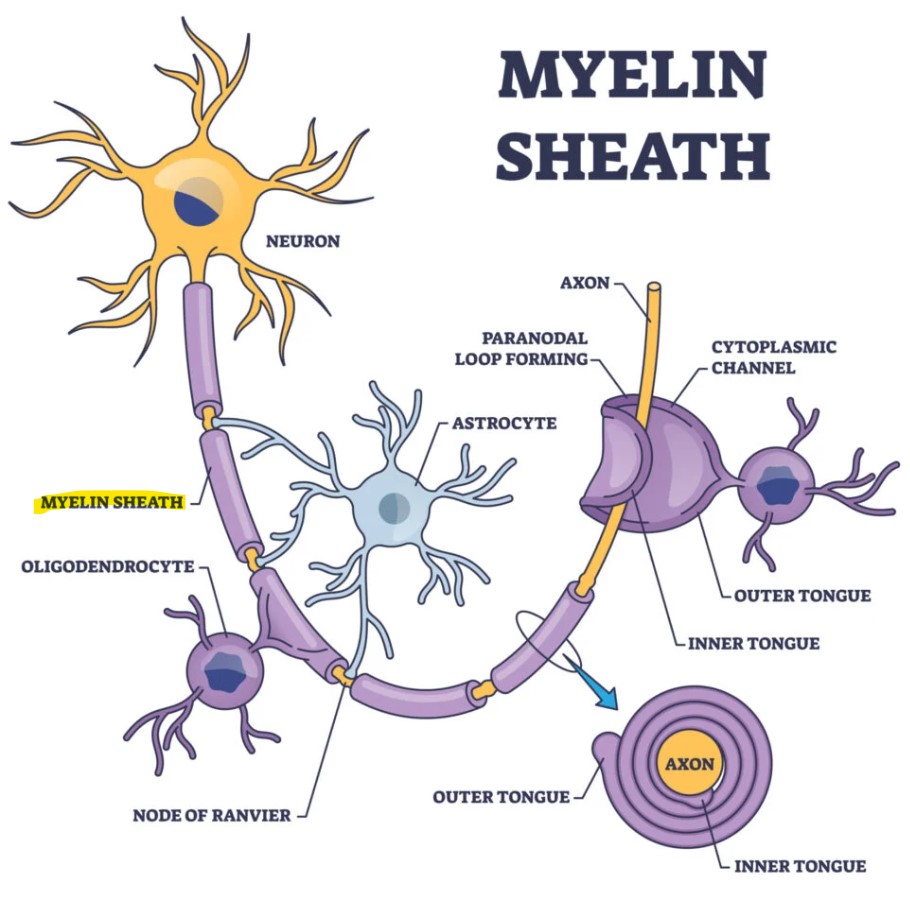
Myelin Sheath
Fatty tissue, that insulates the axons of the neurons; myelin is necessary for normal conduction of electrical impulses among neurons.
Nervous System
The body’s network for electrochemical communication. This system includes all the nerves cells in the body.

Neurons
Individual brain cells

Neurotransmitters
Chemical substance released by the presynaptic terminal button that acts on the postsynaptic cell.

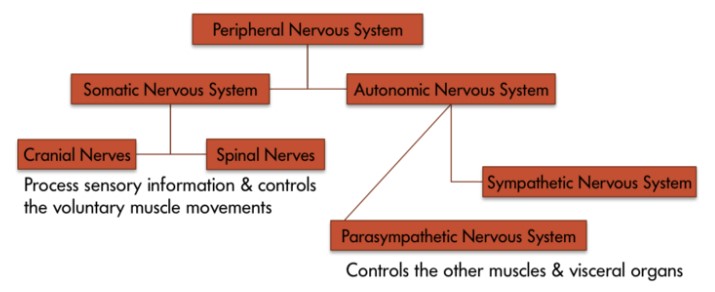
Peripheral Nervous System
All of the nerve cells that connect the central nervous system to all the other parts of the body.
Positron Emission Tomography (PET)
A neuroimaging technique that measures brain activity by detecting the presence of a radioactive substance in the brain that is initially injected into the bloodstream and then pulled in by active brain tissue.

Soma Cell
body of a neuron that contains the nucleus and genetic information, and directs protein synthesis.
Spatial Resolution
A term that refers to how small the elements of an image are; high spatial resolution means the device or technique can resolve very small elements; in neuroscience it describes how small of a structure in the brain can be imaged.
Split-brain Patient
A patient who has had most or all of his or her corpus callosum severed.
Procedure has shockingly low side effects and can be effective at mitigating severe seizures.

Synapses
Junctions between the presynaptic terminal button of one neuron and the dendrite, axon, or soma of another postsynaptic neuron.

Synaptic Gap
Also known as the synaptic cleft; the small space between the presynaptic terminal button and the postsynaptic dendritic spine, axon, or soma.
Temporal Resolution
A term that refers to how small a unit of time can be measured; high temporal resolution means capable of resolving very small units of time; in neuroscience it describes how precisely in time a process can be measured in the brain.
Empirical methods
Approaches to inquiry that are tied to actual measurement and observation.
Ethics
Professional guidelines that offer researchers a template for making decisions that protect research participants from potential harm and that help steer scientists away from conflicts of interest or other situations that might compromise the integrity of their research.
Hypothesis
A logical idea that can be tested.
Systematic observation
The careful observation of the natural world with the aim of better understanding it. Observations provide the basic data that allow scientists to track, tally, or otherwise organize information about the natural world.
Theories
Groups of closely related phenomena or observations.
Confounds
Factors that undermine the ability to draw causal inferences from an experiment.
Correlations
Measures the association between two variables, or how they go together
Dependent variables
The variable the researcher measures but does not manipulate in an experiment.
Presumed result of IV; measured after IV manipulation
Experimenter expectation
When the experimenter’s expectations influence the outcome of a study.
Independent variable
The variable the researcher manipulates and controls in an experiment.
Presumed cause of DV
Longitudinal study
A study that follows the same group of individuals over time.
Operational definitions
How researchers specifically measure a concept.
Placebo effect
When receiving special treatment or something new affects human behavior.
Quasi-experimental design
An experiment that does not require random assignment to conditions.
Random assignment
Assigning participants to receive different conditions of an experiment by chance.
Ambulatory assesment
An overarching term to describe methodologies that assess the behavior, physiology, experience, and environments of humans in naturalistic settings.
Daily Diary method
A methodology where participants complete a questionnaire about their thoughts, feelings, and behavior of the day at the end of the day.
Daily Reconstruction method (DRM)
A methodology where participants describe their experiences and behavior of a given day retrospectively upon a systematic reconstruction on the following day.
Ecological Momentary Assessment
An overarching term to describe methodologies that repeatedly sample participants’ real-world experiences, behavior, and physiology in real time.
Ecological Validity
The degree to which a study finding has been obtained under conditions that are typical for what happens in everyday life
Electronically activated recorder (EAR)
A methodology where participants wear a small, portable audio recorder that intermittently records snippets of ambient sounds around them.
Experience-sampling method
A methodology where participants report on their momentary thoughts, feelings, and behaviors at different points in time over the course of a day.
External validity
The degree to which a finding generalizes from the specific sample and context of a study to some larger population and broader settings.
Full-cycle psychology
A scientific approach whereby researchers start with an observational field study to identify an effect in the real world, follow up with laboratory experimentation to verify the effect and isolate the causal mechanisms, and return to field research to corroborate their experimental findings
Generalization
Generalizing, in science, refers to the ability to arrive at broad conclusions based on a smaller sample of observations. For these conclusions to be true the sample should accurately represent the larger population from which it is drawn.
Internal Validity
The degree to which a cause-effect relationship between two variables has been unambiguously established.
Linguistic inquiry and word count
A quantitative text analysis methodology that automatically extracts grammatical and psychological information from a text by counting word frequencies.
Lived day analysis
A methodology where a research team follows an individual around with a video camera to objectively document a person’s daily life as it is lived.
White coat hypertension
A phenomenon in which patients exhibit elevated blood pressure in the hospital or doctor’s office but not in their everyday lives.
Dualism
Descartes’ Theory: Mind and body are separate entities; the body is material and the mind/soul are immaterial. Mind and body intersect at pineal gland.
In actuality, the pineal gland has many functions, largely to do with regulating internal cycles, particularly sleep.
“Six Ps” of Research
Present, Prompt, Professional, Polite, Private, Prepared
Demand Characteristics
cues that might indicate the research objectives to participants and thus act them to behave unnaturally

Phrenology
Defunct theory by Franz Joseph Gall:
Different functions in different areas of brain (only part proven true)
Moral and intellectual faculties are innate, dependent on organization of an individual’s brain
No opportunity for growth or change
Could feel a person’s head and diagnose/decide occupation by shape

Frontal lobe
The front most (anterior) part of the cerebrum; anterior to the central sulcus.
—responsible for motor output and planning, language, judgment, and decision-making.
—catalyzes response to stimulus (ex. note taking during class)
—assists in the STORAGE of memory

Parietal lobe
The part of the cerebrum between the frontal and occipital lobes; involved in bodily sensations, visual attention, and integrating the senses.

Occipital lobe
The back most (posterior) part of the cerebrum; involved in vision.

Temporal lobe
The part of the cerebrum in front of (anterior to) the occipital lobe and below the lateral fissure.
—involved in vision, auditory processing, (retrieval and creation of) memory, and integrating vision and audition.
—Contains limbic system (amygdala and hippocampus) and is associated with language, emotion, and fight/flight/freeze responses
Assimilation
interpreting new experiences in terms of existing mental structures (Piaget)
Accommodation
changing existing mental structures to explain new experiences (Piaget)

Construct
a theoretical concept, theme, or idea based on empirical observations. It's a variable that's usually not directly measurable and may conflict with the operational definition used in a study
Reactance (“Bad Participant” Reaction)
a participant effect/motivational state that occurs when people feel their freedom of choice is being threatened. may interfere with studies/be a confounding factor if participants rebel (it’s annoying to researchers but easy to spot and consider).

Neuronal Communication
Explosion of ions (action potential) occurs
Neurotransmitters sent into synapses
NTs “turn on” or “turn off” other neurons
^How everything in your brain/body occurs

Pilot Study
a small feasibility study designed to test various aspects of the methods planned for a larger, more rigorous, or confirmatory investigation
Case Study
a process or record of research in which detailed consideration is given to the development of a particular person, group, or situation over a period of time.
Sample vs Population
A population is the entire group that you want to draw conclusions about.
A sample is the specific group that you will collect data from

Hot vs Cold Cognitions
Cold cognition = rational, unemotional
Hot cognition = impulsive, emotional
Cold cognition largely originates from prefrontal cortex; when prefrontal cortex is overrun, hot cognition occurs.
Ideas become research:
Develop a research question from an idea (IV, DV, controls if possible)
Create a specific hypotheses that is both testable and predictable
Develop operational definitions that are reliable (only one thing measured) and valid (correlate positively to the hypothesis/”correct” thing is measured).
Conduct a study
Draw conclusions
Produce public knowlege
Spectrums of Research
Basic ←→ Applied
Qualitative ←→ Quantitative
Lab Study ←→ Field Study
Correlational ←→ Experimental

Basic Research
Works to extend the general definition of fundamental scientific phenomena; looks a the “basics” to see how things work.

Applied Research
Seeks to solve a particular practical problem through the application of psychological research.
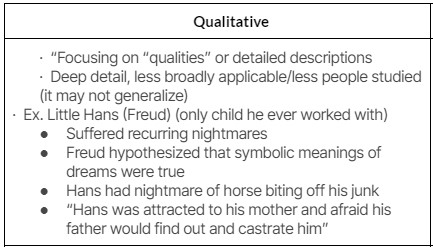
Qualitative Research
Focusing on “qualities” or detailed descriptions
Deep detail; less people are studied and their experiences may not generalize, meaning the findings may not always be broadly applicable.

Quantitative Research
Focuses on “quantities,” or numerical representations summarizing qualities.
More people are studied in less detail, yielding general numeric trends with less specifics than qualitative research.

Lab Study
An research study where participants know they are being observed (likely obvious in many aspects). Primarily gauges how people think.

Field Study
Conducted outside a lab where many/all participants do not know they are being observed (less obvious). Primarily gauges how people act.

Correlational Research
Tracking the prevalence/co-occurrence of variables over time

Experimental Research
Manipulating variables to measure their effect on other variables.

Institutional Review Board (IRB)
An institutional entity charged with providing ethical and regulatory oversight of research involving human subjects. With the safety and rights of research participants as their highest priority, an IRB has the authority to approve, require modifications in (to secure approval), or disapprove research.

Aristotle (384 - 322)
A seminal figure in philosophy who piloted many theories about thinking and human behavior. He believed mental functions were located in the heart (the heart racing during intense feelings influenced this idea). Also believed the brain was a temperature regulator of blood, that your brain makes you “cool headed”.

Descartes (1696 - 1650)
Among the first to map out human reflexes. Extremely interested in the “hows” and “whys” of behavior (thus his emphasis on proofs and famous “I think therefore I am” adage). Piloted Dualism, or the idea of a material body and non-material soul that intersect at the pineal gland in the center of the brain.
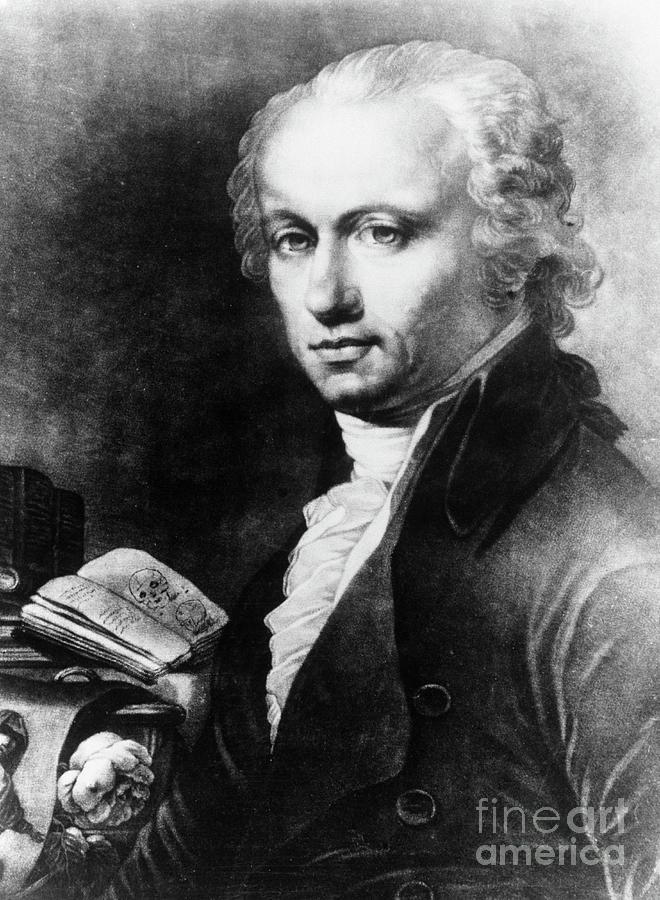
Franz Joseph Gall (1758 - 1828)
A physician who was among the first to believe different parts of the brain supported different functions. This belief led to his now-debunked theory of phrenology.
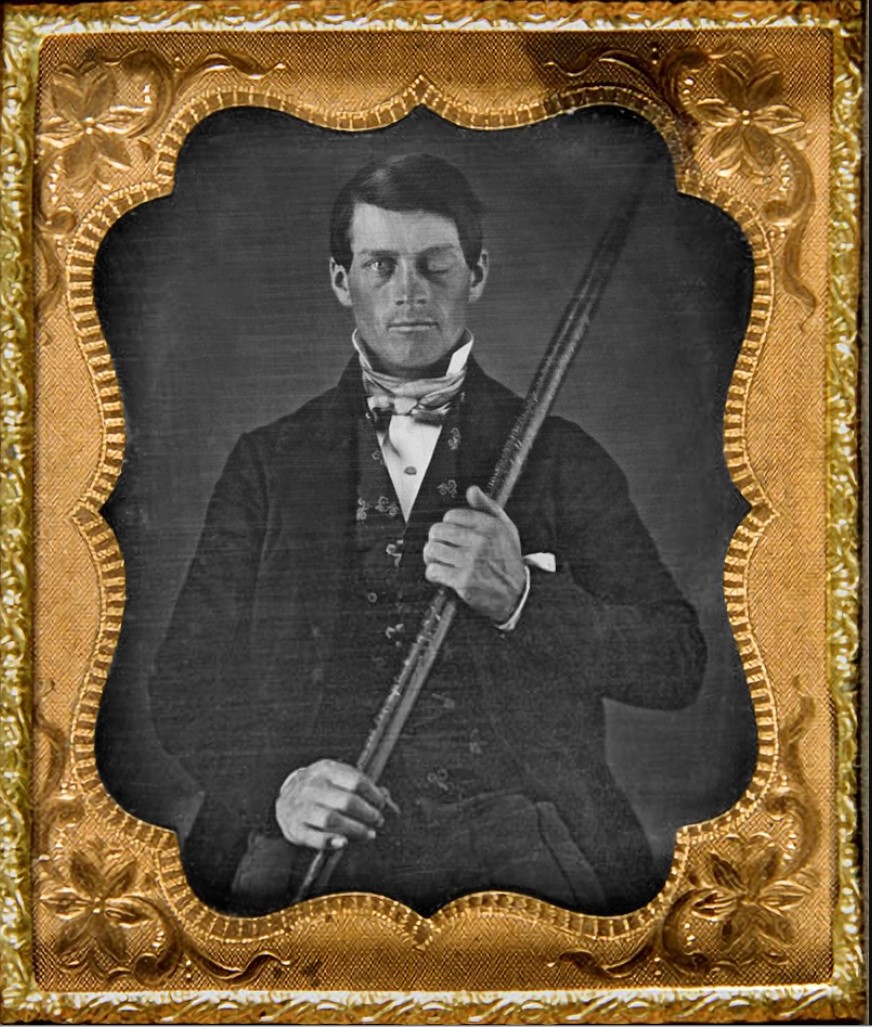
Phineas Gage (1848)
A famous patient who suffered brain damage from a tamping iron impalement. Severe head trauma occurred to Gage’s frontal lobe. He remarkably survived, but his temperament changed drastically. Showed scientists the importance of the frontal lobe in defining personality.

Gyri
Ridges or folds between two clefts on the cerebral surface in the brain; the neuron-containing “wrinkles” that make up grey matter.
More gray matter generally indicates a higher cognitive capacity.

Sulci
Furrows on the surface of the brain (the “spaces” between wrinkles).
Human Participant Ethics
Informed consent & knowledge of participation: participation must be voluntary and without coercion
Confidentiality: data is either anonymous or de-personalized; information is not made public outside of the conditions participants consented to
Privacy: no stalking people or studying them in private locations w/o consent. (Public locations are largely considered fair game for field research).
Benefits v Risks: researchers and ethics boards (usually an IRB) decide whether research is worth it based on potential harms v knowledge
Deception: if participants are lied to during the study, they need to be told the truth (debriefed) after it occurs
Serotonin
A neurotransmitter that plays a role in mood regulation, emotional well-being, sleep, appetite, and cognitive functions.
Dopamine
A neurotransmitter associated with pleasure, motivation, and motor control of the body; a part of the reward system.
Principles of Causality
Must be fulfilled to draw a causal statement from an experimental study.
IV MUST precede DV
Ex. you push (IV) someone and then they fall (DV)
IV and DV covary
The IV and DV must appear to change together
No alternative explanation for change in DV
Everything else held constant (i.e. no confounding variables)
It makes theoretical sense that the IV would cause the DV
Participant effects
Negative effects occurring when participants are not responding naturally or honesty (ex. reactance/”bad participant” behavior, “good participant” behavior, and “socially desirable” participant behavior).
Experimenter effects
The person doing research’s bias can impact the result as they subconsciously want to be correct and may subtly influence participants towards a particular end (ex. introducing demand characteristics, not treating groups equally).
SOLUTIONS to experimenter effects
Double-blind procedure: don’t tell the researchers what condition a participant has been when they come in for the successive parts of the study, and don’t tell participant which different conditions exist
Automation: show the same video/same sheet of instructions to participants; do not have different conversations/build rapport with them (unless the study calls for it)
“Socially Desirable” Participant
Will tell pro-social lies (lies told to foster connection and make others feel better) to make themselves look better (ex. that they would help a stranger in distress on the street when they know they wouldn’t). Can skew research. A confounding participant effect.
“Good” Participant
Tries to figure out what the study is doing and tries to “help” the researcher prove it true. Can get researchers accused of fraud if the participant’s unnatural behavior creates results that are non-replicable. A confounding participant effect.
Broca’s Aphasia
motor production of speech impaired after brain injury (signal not sent to vocal cords)
Wernicke’s Aphasia
understanding of language impaired (spoken or written)